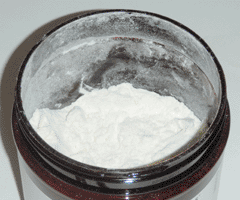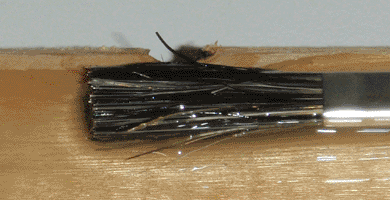


Although gelatine glue is strong and fast-acting, it does have some significant limitations. It must be applied fresh, hot, and quickly; this makes it impossible to use on large or complex joints, and difficult to use in general. To overcome this, I decided to make a glue based on another common protein: casein. Casein is an alkali-soluble form of milk protein, and can be precipitated from (preferably skim) milk by the addition of vinegar. Historically this would then be dissolved with quicklime (calcium oxide) to make glue, but this would then harden in its container within a day. Fortunately, a shelf-stable liquid glue can be made if ammonia is used instead.
For convenience and accuracy of measurement, I decided to use micellar casein powder (available as a protein supplement) as my source of casein, and clear household ammonia (3-5% ammonium hydroxide) to dissolve it. The dissolution is very slow, with the casein tending to clump and form a skin; furthermore, it cannot be accelerated by heat without denaturing the casein and producing obnoxious fumes. However, if the mixture is stirred occasionally and kept covered otherwise, the reaction will be complete within a day or two. After extensive experimentation, the maximum concentration of casein I was able to achieve was 10% by weight, or a 1:9 ratio of casein to ammonia. This appears to be limited by the solubility of the ammonium caseinate rather than by a shortage of alkali, since all samples contained excess ammonia. Fortunately, despite its low concentration, this solution still makes an effective glue.
The glue is slippery and brushes onto wood easily, and remains fluid for much longer than gelatine, since it solidifies due to evaporation rather than cooling. As it dries it gives off weak fumes of ammonia, gradually reverting back to insoluble casein. The glued joints can be handled within an hour, but reach full strength in a day, and when dry they are fairly water-resistant. Mechanically, the glue is approximately half as strong as gelatine, with the cantilever test used in the gelatine glue article failing at just over 15 pounds of weight. This is likely due to the low casein content causing the glue to shrink considerably as it dries. This is somewhat beneficial however, as any excess glue tends to be pulled back into the joint during this shrinkage, resulting in a fairly minimal glue line.
Overall this is an interesting adhesive, and I will continue to experiment with its properties in order to maximize its strength and water-resistance. Like gelatine, it can be used as both glue and sizing (to seal wood before varnishing), but it also has another practical use which I will explore in the next article: it can be made into paint.
Glue prepared in this way remains stable for approximately one month, after which it first solidifies, and then becomes entirely liquid. This is likely due to excess ammonia decomposing the casein proteins, so the shelf life may possibly be extended by replacing some of the household ammonia with water.
EDIT: 1/1/2021Further experimentation revealed that while excess ammonia does shorten the life of the glue slightly, the effect is minimal and ammonia-based casein glues have a relatively fixed shelf-life of one month. The minimum ammonia content (as NH3) appears to be 5-10% of the weight of the casein; for comparison, the original formula provides up to 45%. A significant improvement can be made by using high quality granular casein (available as an art supply) and soaking it in water before stirring in the required amount of ammonia in the most concentrated form available. This greatly reduces the time required to fully dissolve the casein, and allows for glue concentrations of up to 25%, although at this point the glue is more like a putty. In general, with this improved method the optimal casein concentration appears to be 15-20% by weight of the total solution, which produces a glue nearly as strong as gelatine.
This glue can also be made completely waterproof by the addition of zinc acetate (dissolved in the ammonia solution) at 10% of the weight of the casein, and by increasing the ammonia content to 20% of the casein weight to accomodate for the acidity of this salt. Casein is crosslinked by divalent metals, but the ammonia successfully complexes the zinc until the glue dries. This is clearly visible: the glue is initially a translucent liquid, then becomes a white gel within an hour of being applied, and finally becomes transparent and glassy when fully cured. Unfortunately this addition reduces the shelf life to approximately a week; however this is still plenty of time to assemble a project, and the absolute waterproofness makes it worthwhile.
Finally, another variation can be made by using borax (at 20% of the weight of the casein) instead of ammonia. This requires a high grade of casein since borax cannot saponify residual fats, but produces a highly stable and nearly pH-neutral glue. This can be further improved by simmering the glue batch in a double boiler for 15 minutes to destroy any enzymes remaining in the casein, and by adding a drop of clove oil as a preservative. This type of glue dries to a surprisingly flexible film, remains completely soluble in water, and has a mild and pleasant odor; these characteristics make it ideal for use as a general-purpose craft glue, particularly for gluing paper as it has no tendency to soak through.
EDIT: 3/27/2025The borax-casein glue described above can be further refined by replacing some of the casein with wheat flour. This dissolves during the simmering process and makes the glue into somewhat of a gel, rather than a syrupy liquid. Furthermore, the borax alone is capable of preserving the glue, eliminating the need for clove oil. This improved glue is highly shelf-stable, and is a genuine upgrade from modern PVA-based wood glue. In particular, its thixotropic nature allows it to be applied to vertical surfaces without running, and it remains slippery for about fifteen minutes, allowing the assembly of complex joinery. Furthermore, despite its flour content, it still dries fully overnight and retains the strength of the original glue. Specifically, the weight ratios of the ingredients are as follows: three parts casein, one part wheat flour, one part borax, and twenty parts water, stirred together and simmered for fifteen minutes in a double-boiler.
EDIT: 6/15/2025While wheatpaste and casein are both independently stabilized by borax for a considerable time (up to a year), it appears that in combination the two become incompatible, and my initial assumption of stability was mistaken. The above glue modification, while initially useful, begins to separate after a month of storage and shortly thereafter becomes thin and weak. However, it is likely possible to use wheatpaste alone where a thixotropic glue with a long open-time is needed, and this will be the subject of a future article.
Generally speaking, the original formula for casein glue appears to be the most useful, and with high quality starting materials, a glue can be made from one part casein and four parts household (5%) ammonia by weight, ideally mixed the day before use. As described above, this can be made truly waterproof using zinc acetate, and I have found that a 5% solution of zinc acetate in household ammonia makes a useful hardening additive. This should be added immediately before use, in a ratio of hardener to glue ranging from 1:3 to 1:1. Copper acetate may also be used in the same manner and in the same proportions, providing enhanced preservative properties at the expense of transparency and color, becoming semi-opaque and green once dry.